Hand Gripper Hackathon and Challenge
Medizintechnik II is a week-long hackathon for Bachelor of Human Medicine students, focusing on project-based learning. The 5-day design sprint challenges participants to create a gripper module for an elbow exoskeleton, incorporating control mechanisms. Inspired by CYBATHLON, the competition involves using the developed assistive technology for daily tasks.
Building on Medizintechnik I, the course explores restoring movement in spinal cord injury patients through exoskeleton technology. It integrates human factors, design, sensing, actuation, control, and user evaluation, fostering transdisciplinary skills. The week includes interactive workshops, presentations, and group work, with students assigned roles like design, software engineering, electronics, user evaluation, and group lead, enhancing their learning experience.
The Medical Engineering II (Medizintechnik II) block course is a one-week hackathon promoting project- based learning via an intense hands-on project at the interplay between medicine and engineering. It is carried out in the form of a 5-day design sprint in which students in the Bachelor of Human Medicine (Humanmedizin) conceptualize and develop an assistive technology in the form of a gripper module for an elbow exoskeleton. They then implement means to control the gripper and compete in a challenge inspired by the CYBATHLON, in which daily life tasks must be carried out using the developed assistive technology.
The course directly builds on Medical Engineering I (Medizintechnik I), which provides the scientific and engineering foundations as well as practical skills on the restoration of movement in persons with spinal cord injury through exoskeleton technology, including human factors, design, sensing, actuation, control, and user evaluation, thus making use of their prior knowledge, and promoting their transdisciplinary skills.
The week consists of a mix of highly interactive input workshops, presentations by persons with disabilities and medical technology companies, as well as group work. During this, students work in groups of 5 and are tasked to distribute the different group roles (i.e., focusing on design/prototyping, software engineering, electronics/sensing, user evaluation/presentation and group lead) to which they receive separate introductions (Input, see Figure 1).
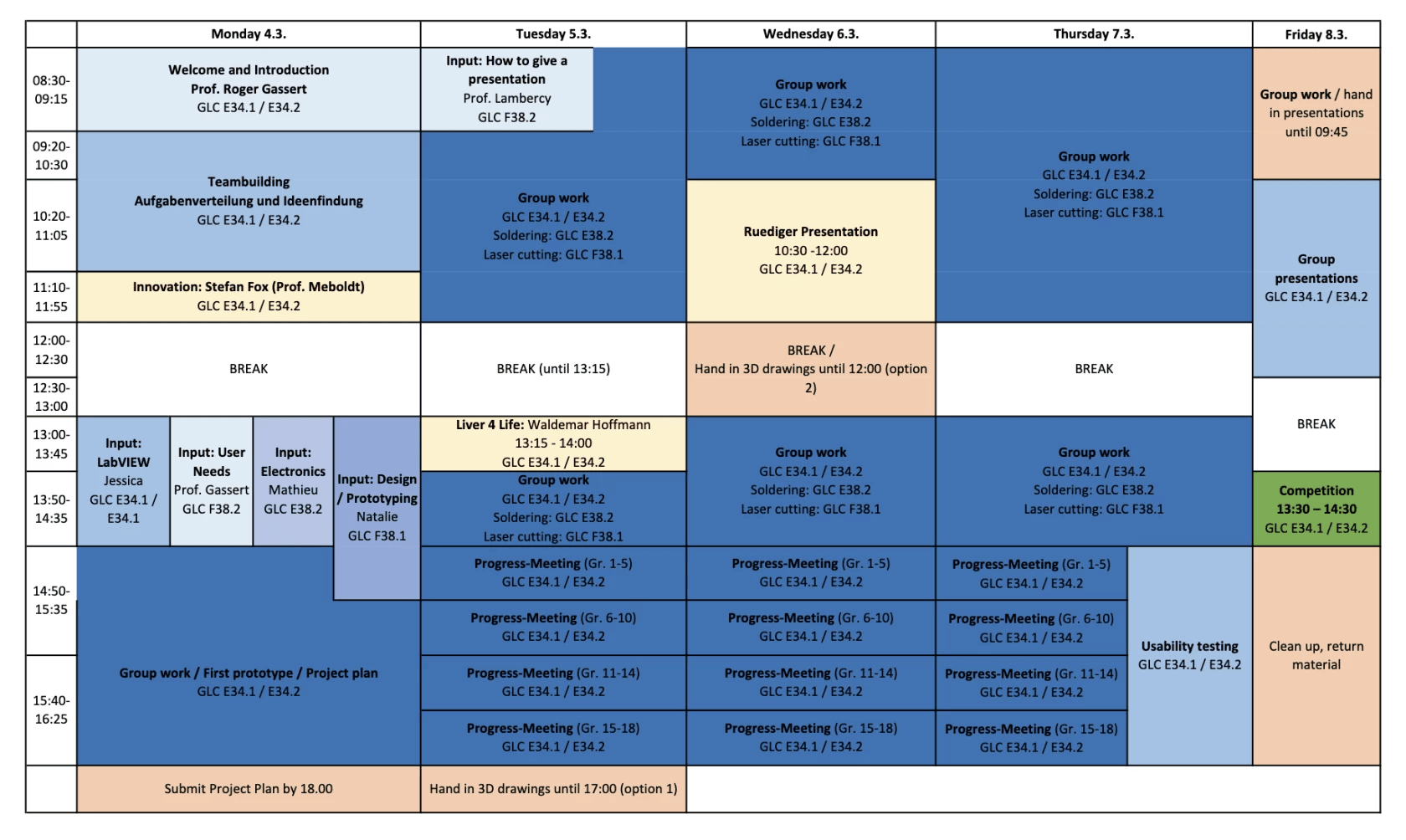
During the project work, students revisit the theoretical learnings from the previous semester and apply their knowledge practically throughout the development of their individual prototype of the gripper module. They monitor their progress and discuss ways to address unforeseen challenges in daily progress and feedback meetings with a dedicated coach (teaching assistant), to promote critical thinking, project planning and management skills (Progress Meeting, see Figure 1). Students evaluate the developed prototype in a group-internal user study and compare it against those of the other groups in the final competition at the end of the week.
Input workshops, presentations from external experts and the group presentations/competitions each make up about 10% of the week, while the remaining 70% are dedicated to active teamwork and progress meetings.
Students receive continuous feedback throughout the week. The input workshops contain interactive elements, such as, e.g., the development of a storyboard in the user needs workshop which are then discussed among the workshop participants. The group work is assessed in progress meetings on days 2–4, in which students receive and can also seek specific feedback. Furthermore, students can self- assess their achievements by preparing for and observing their performance in the challenge.
The active engagement of students is required during approximately 70% of the week, specifically during a team-building project, project work phases, a 5-minute presentation and during the competition.
Students can ask questions during and following input workshops, the highly interactive presentations by persons with disabilities and the daily progress meetings with project leaders. They also receive technical support by trained assistants throughout the week. The project plan submitted on the first day allows them to track progress within the group, and the person selected as team leader is tasked to assure and facilitate communication between the group members. Furthermore, students are encouraged to exchange with members of the other groups executing the same role (peer feedback).
The work is assessed in the form of both a 5-minute presentation by each team, in which they are asked to highlight a special aspect of their development, as well as through their performance in a competition (see Figure 2) that is inspired by the arm prosthesis race of the CYBATHLON. In the competition, performance and time to complete specific daily life tasks with the assistance of the developed device are assessed.
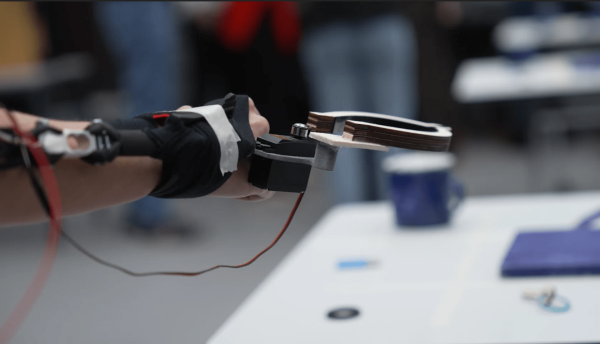
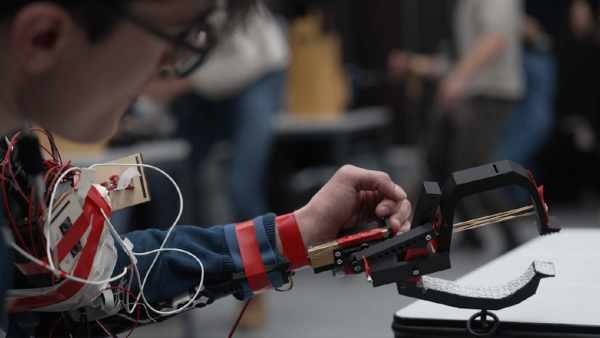
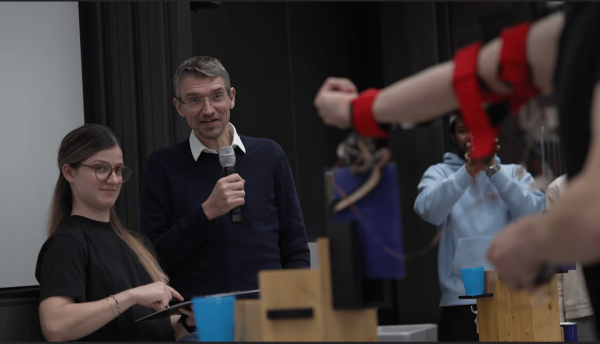

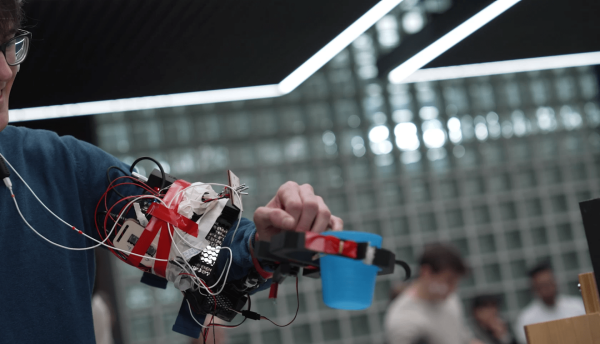
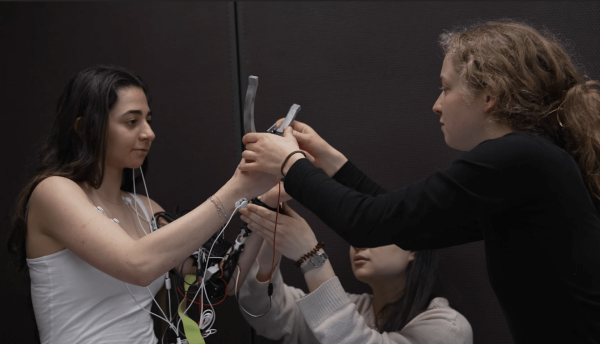
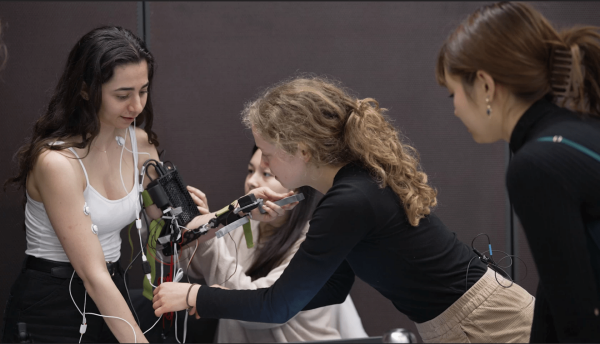
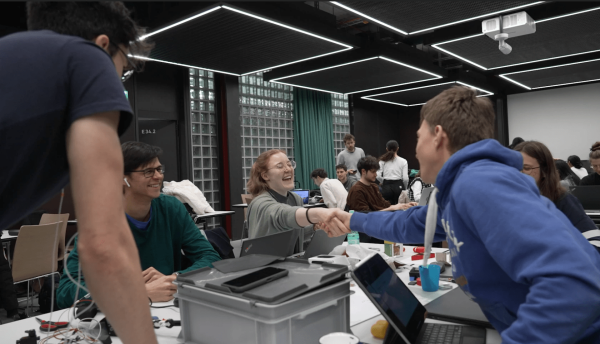


Which methods, tools or strategies did you use to encourage student engagement for learning success?
We employ a mix of teaching elements and tools to make the week engaging and varied. After a general introduction and problem definition, students form groups and perform a teambuilding activity. They then receive interactive input workshops on different topics of relevance for the entire group, and/or according to their role within the group to gain additional skills relevant for the project. Additional interactive presentations by persons with disabilities and a medical technology company complement the group work. Deadlines to submit a project plan on the first day and the technical drawings by noon of the third day together with the planned daily progress meetings and the competition on the last day ensure high engagement of the students throughout the week.
The provided rapid prototyping hardware allows students to implement and test their ideas, making this course a potentially unique opportunity for medical students to conceptualize a technological device from beginning to end, and face the corresponding challenges of medical technology development. This, combined with the fast pace of the hackathon format, the close supervision by trained coaches, as well as the desire to perform well in the group competition ensures high student engagement. In the four years that we have now carried out this course, each year with 20 groups, all groups managed to present a functioning prototype, underlying the high level of student engagement.
In contrast to Medizintechnik I, which is graded, Medizintechnik II is pass/fail, and thus based on active participation of the students. The high engagement of students to develop and optimize their prototypes and their impressive achievements demonstrate the success of this approach. The three top groups in the challenge receive a small gift and award and are celebrated by their peers.
The innovative elements of the course
We implemented several innovative elements within this course, with the specific objective of increasing the awareness and interest of medical students for engineering and product development processes, and preparing them for future collaboration with engineers:
- The course directly builds on the theoretical and practical skills the students acquired in the previous semester, allowing to strengthen these skills in a hands-on project. Being able to build a functioning prototype and see it perform in a competition is highly rewarding for the students, as it demonstrates what they can achieve based on their learnings.
- To let students evaluate which group role they feel most comfortable with, we carry out a teambuilding activity on the morning of the first day, directly after forming the groups. In the “eggs can fly challenge”, each group receives 2 sheets of paper, 2 balloons, 1m of cord, 1 roll of tape, 1 pair of scissors and two Kinder surprise eggs.
- Within 30 minutes, each group needs to plan and build a structure that can safely guide the egg from the Polyterrasse to the ground below without the egg breaking. Following this teambuilding activity, students are encouraged to reflect on the role they took on within the group (e.g., project lead, design, implementation). This initial recreative challenge sets the fast pace of the hackathon and serves as an exercise to promote ideation and communication within the groups to optimise team building.
- The active engagement of students is required throughout the week, to prepare and submit the required documents, check and update on their progress and reflect on possibilities to react to unforeseen challenges during the daily progress meetings, and when presenting their results in a presentation and competing in the challenge on the last day. On the first day, they are required to submit a project plan in which they define their target and how they plan to reach it. These aspects promote teamwork, critical thinking, and project management beyond what is usually treated in standard classroom lectures.
- In addition to the support of the assistants, we provide interactive videos and checklists to help students in independently reflecting on and solving their problems before they approach the assistants. To allow students to realize their prototypes, we provide and support infrastructure for cardboard prototyping, laser cutting, 3D printing, soldering and basic mechanical assembly. Having access to and training on such tools provides a unique experience for medical students and promotes their awareness for the complexity and challenges as well as the many opportunities of medical technology product design and manufacturing.
- As assistants, we recruit former students who carried out this course and continue their master’s studies in medicine at the University of Zurich, as well as students that already collected experience with similar hardware in our Physical Human-Robot Interaction course. This offers the advantage of receiving feedback from their peers, as well as opportunities for discussing career paths and personal development.
- To better highlight the relevance of the project for people with disabilities and introduce engaging elements throughout the week, we invite persons with disabilities to present their stories in interactive sessions and address their wishes to the students who will become future medical doctors. We see this as a unique way to practically experience user-centred design and go beyond the theoretical concepts.
- The block course is designed as a five-day design sprint, as these are often carried out in companies (e.g., Google), and serves as a tool that can basically be extended and applied to any type of development project. It covers the phases problem/target definition, ideation, selection of the solution that best addresses the problem, realizing a prototype and refining it in several rapid iterations, and then evaluating the prototype with the “customers”, here represented by the user evaluation within the group and the participation in the competition.
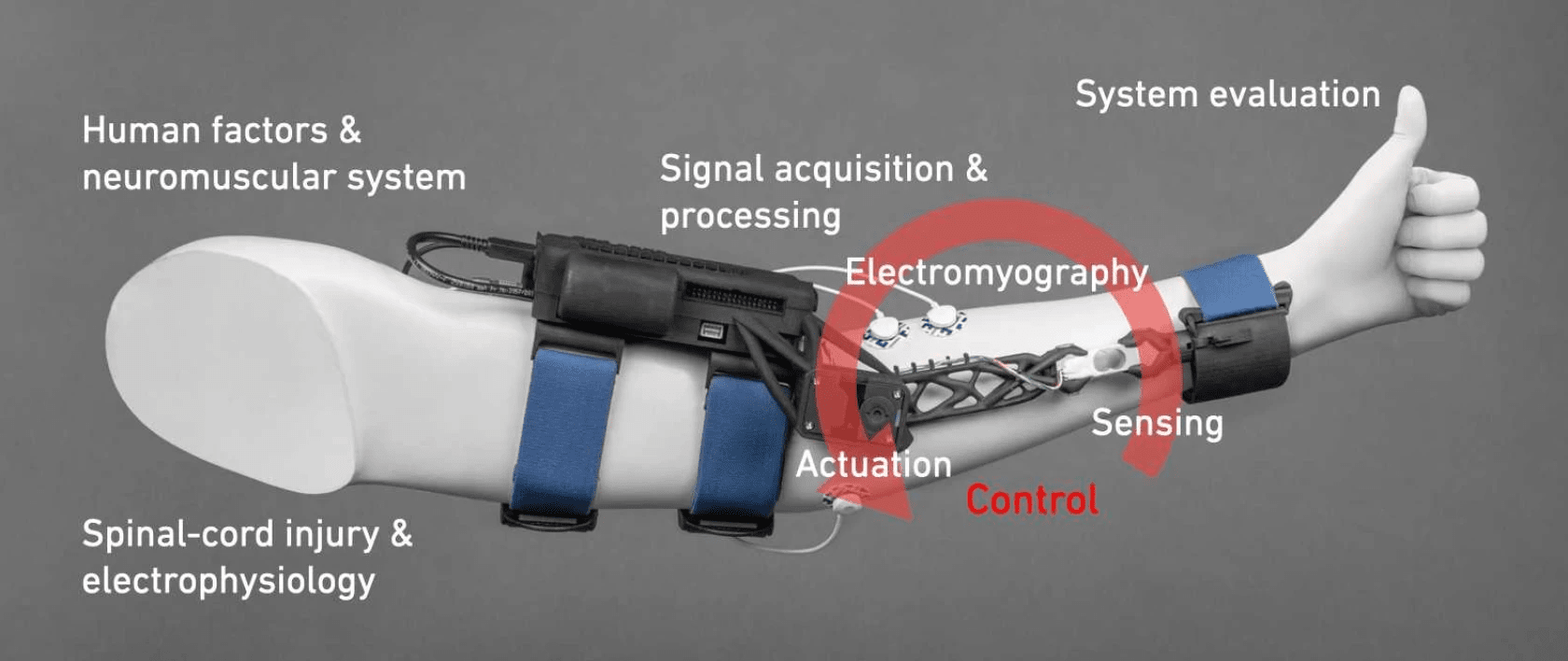
All groups (about 80 groups over the past four years in which we have carried out this block course) performed well in the competition, some exceptionally well and with highly innovative elements (e.g., control of the gripper by the facial muscle, or innovative gripper designs using a parallelogram structure allowing a parallel movement of the grippers), showing students that they could transfer their learnings from the previous semester, apply them to successfully solve a specific problem, and go beyond what they thought they were capable of.
Students were highly engaged, quickly realized first prototypes using cardboard, and refined them before moving on to laser cutting and 3D printing. Several groups asked for more advanced components to implement their innovative ideas, which we tried to provide during the week. Several students mentioned that the ability to hold their design in their hands and see it perform during the competition was highly gratifying.
In summary, this course touches on the essence of what ETH can offer to medical students. A truly hands- on medical technology development experience, following engineering methodologies, that no other medical curriculum can offer.
Which elements of your project would you recommend to others?
We strongly believe that project-based learning in groups helps students strengthen their understanding of theoretical concepts and link them to practical application. Allowing them to realize their design ideas as physical prototypes further strengthens this process. The need to continuously test, evaluate and improve their developments promotes the critical thinking skills of students. Finally, participating in the CYBATHLON-inspired competition shows students what they can achieve using the skills they acquired throughout the previous semester (Medizintechnik I) and the hackathon.
In our particular case, framing the project around the challenges of specific patient populations (persons with high-level spinal-cord injury and amputees) gives medical students a context to which they can directly relate. This approach can be applied for any specific study curriculum.
Project team
- Ortsangabe location_onGLC G 20.2
- Telefon phone+41 44 632 32 66
- E-Mailemailroger.gassert@hest.ethz.ch
Rehabilitation Engineering
Gloriastrasse 37/ 39
8092
Zürich
Schweiz

- Ortsangabe location_onGLC G 21.1
- Telefon phone+41 44 632 71 66
- E-Mailemailolivier.lambercy@hest.ethz.ch
Inst. f. Robotik u. Intell. Syst.
Gloriastrasse 37/ 39
8092
Zürich
Schweiz
- Ortsangabe location_onGLC G 21.2
- Telefon phone+41 44 510 72 31
- E-MailemailGiada.Devittori@hest.ethz.ch
Rehabilitation Engineering
Gloriastrasse 37/ 39
8092
Zürich
Schweiz
Rehabilitation Engineering
Gloriastrasse 37/ 39
8092
Zürich
Schweiz